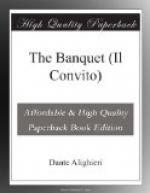CHAPTER XXIII.
Since the definition of Nobility is sufficiently demonstrated, and since in all its parts it has been made as explicit as possible, so that we can now see who is the Nobleman, it seems right to proceed to the part of the text which begins, “Souls whom this Grace adorns,” in whom appear the signs by which it is possible to know the Noble Man.
This part is divided into two. In the first it affirms that this Nobility is resplendent, and that it shines forth manifestly during the whole life of the Noble Man; in the second it appears specifically in its glory, and this second part begins, “In Childhood they obey.” With regard to the first part, it is to be known that this Divine seed, which has been previously spoken of, germinates immediately in our Soul, combining with and changing its form with each form of the Soul, according to the exigency of that power. It germinates, then, as the Vegetative, as the Sensitive, and as the Rational, and it branches out through the virtues or powers of all of them, guiding all those to their perfection, and sustaining itself in them always, even to the point when, with that part of our Soul which never dies, it returns to the highest and the most glorious Sower of the seed in Heaven; and it expresses this in that first part which has been mentioned. Then when it says, “In Childhood they obey, Are gentle, modest,” it shows how we can recognize the Noble Man by the apparent signs, which are the Divine operation of this goodness. And this part is divided into four, as it is made to represent four different ages, such as Adolescence, Youth, Old Age, and Extreme Old Age. The second part begins, “Are temperate in Youth;” the third begins, “Are prudent in their Age;” the fourth begins, “The fourth part of their life.” Herein is contained the purpose of this part in general, with regard to which it is desirable to know that each effect, inasmuch as it is an effect, receives the likeness of its cause in proportion as it is capable of retaining it.
Wherefore, since our life, as has been said, and also the life of every living creature here below, is caused by Heaven, Heaven is revealed in all such effects as these, not, indeed, with the complete circle, but with part of it, in them. Thus its movement must be not only with them, but beyond them, and as one arch of life retains (and I say retains, not only of men, but also of other living creatures) almost all the lives, ascending and descending, they must be, as it were, similar in appearance to the form of the arch. Returning, then, to our course of life which at present we are seeking to understand, I say that it proceeds after the manner of this arch, ascending and descending. And it is to be known that the ascent of this arch should be equal to its descent, if the material of the seed from which we spring, so complex in its nature, did not impede the law of Human Nature. But since the humid root




